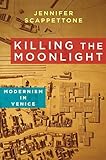Killing the Moonlight : Modernism in Venice / Jennifer Scappettone.
Material type: TextSeries: Modernist latitudesPublisher: New York : Columbia University Press, [2014]Copyright date: ©2014Description: 1 online resource (440 pages) : color illustrationsContent type:
TextSeries: Modernist latitudesPublisher: New York : Columbia University Press, [2014]Copyright date: ©2014Description: 1 online resource (440 pages) : color illustrationsContent type: - text
- computer
- online resource
- 9780231537742
- 0231537743
- 0231164335
- 9780231164337
- Modernism in Venice
- Venice (Italy) -- In literature -- History
- Literature, Modern -- 19th century -- History and criticism
- Literature, Modern -- 20th century -- History and criticism
- Modernism (Literature)
- Venice (Italy) -- In art -- History
- Modernism (Aesthetics)
- Littérature -- 19e siècle -- Histoire et critique
- Littérature -- 20e siècle -- Histoire et critique
- Modernisme (Littérature)
- Modernisme (Esthétique)
- LITERARY CRITICISM -- European -- Italian
- Literature
- Literature, Modern
- Modernism (Aesthetics)
- Modernism (Literature)
- Italy -- Venice
- 1800-1999
- 809.9335845311 809/.9335845311
- PN56.3.V4 S38 2014
| Item type | Home library | Collection | Call number | Materials specified | Status | Date due | Barcode | |
|---|---|---|---|---|---|---|---|---|
 Electronic-Books
Electronic-Books
|
OPJGU Sonepat- Campus | E-Books EBSCO | Available |
Includes bibliographical references and index.
Introduction: Venetian Modernity: A Troubled Present -- 1. "The Entanglement of Memory": Reciprocal Interference of Present and Past in Ruskin's Venetian Histories -- 2. Nearer Distances and Clearer Mysteries: Between Patches and Presence in James's "Visitable Past" -- 3. Adriatic Fantasies: Venetian Modernism Between Decadence -- 4. From Passéism to Anachronism: Material Histories in Pound's Venice -- 5. Fabulous Planning: Unbuilt Venices -- Coda: Laguna/Lacuna.
"As a city that seems to float between Europe and Asia, removed by a lagoon from the tempos of terra firma, Venice has long seduced the Western imagination. Since the 1797 fall of the Venetian Republic, fantasies about the sinking city have engendered an elaborate series of romantic cliches, provoking modern artists and intellectuals to construct conflicting responses: some embrace the resistance to modernity manifest in Venice's labyrinthine premodern form and temporality, while others aspire to modernize by 'killing the moonlight' of Venice, in the Futurists' notorious phrase. Spanning the history of literature, art, and architecture -- from John Ruskin, Henry James, and Ezra Pound to Manfredo Tafuri, Italo Calvino, Jeanette Winterson, and Robert Coover -- Killing the Moonlight tracks the pressures that modernity has placed on the legacy of romantic Venice, and the distinctive strains of aesthetic invention that resulted from the clash. Whether seduced or repulsed by literary cliches of Venetian decadence, post-Romantic artists found a motive for innovation in Venice. In Venetian incarnations of modernism, the anachronistic urban fabric and vestigial sentiment that both the nation-state of Italy and the historical avant-garde would cast off become incompletely assimilated parts of the new. Killing the Moonlight brings Venice into the geography of modernity as a living city rather than a metaphor for death, and presents the archipelago as a crucible for those seeking to define and transgress the conceptual limits of modernism. In strategic detours from the capitals of modernity, Scappettone charts an elusive 'extraterritorial' modernism that compels us to redraft the confines of modernist culture in both geographical and historical terms"--Provided by publisher.
Print version record.
English.
eBooks on EBSCOhost EBSCO eBook Subscription Academic Collection - Worldwide
There are no comments on this title.

